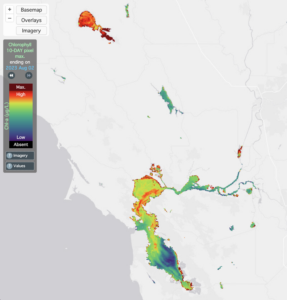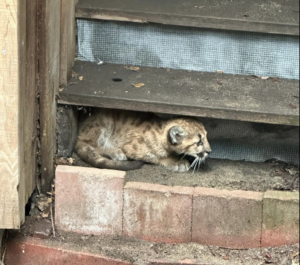Q: Why do seven-gill sharks have seven gills? Do they need larger gill structures due to San Francisco Bay’s water chemistry? If so, what about leopard sharks and the other five-gill sharks in the Bay? [Chris, San Francisco]
A: Truth is, Chris, no one really knows why seven-gill sharks have seven gill slits while most other sharks have only five. In fact, of the hundreds of species of cartilaginous fish–sharks and rays–only a handful do not have five gills. It’s probably just a quirk of evolutionary history. There are several species of sharks that thrive in a very similar habitat to the seven-gill but do fine with only five gills. (Unlike sharks and their kin, most fish have just one visible gill slit, but behind that bony plate they typically have four pairs of gills.)
Seven-gill sharks are distributed in nearly every ocean in the world except the Mediterranean and North Atlantic. In the open ocean they occupy the deepest parts of continental shelves down to 2,000 feet; when found closer to shore in bays and inlets, they are always in the deepest parts. They prefer rocky bottoms but are also found over sand.
Our local species, the broad-nosed seven-gill shark, is one of San Francisco Bay’s top predators (up to eight feet long and 250 pounds). Our bay and Humboldt Bay to the north are breeding areas where females give birth to 25 or more live young after a gestation of 10 to 12 months. Though it’s a formidable predator, the seven-gill is not really dangerous to humans. We’ve been dangerous to them, however: In the 1930s and ’40s they were heavily exploited in the Bay for liver oil, but the commercial fishery eventually collapsed. The seven-gill is now caught only by sport anglers, who fish right from the shore, where seven-gills will venture as they hunt for prey. And they consider everything food, including those leopard sharks and other five-gills you asked about. They also eat rays, octopus, bony fish, harbor seals, porpoises, and carrion. Their only predators are great white sharks and larger seven-gills. Yes, they are cannibals!
This intriguing animal has attracted the attention of many local researchers. In 1990 a seven-gill was captured in Humboldt Bay and taken to Monterey Bay Aquarium, where it was put on display for four years. When it became clear the shark was not doing well in captivity, aquarium staff tagged and released it in Monterey Bay. It was recaught three years later in Humboldt Bay, its original home. That means seven-gills can navigate and have some fidelity to their home turf. In 2008 researchers with the Aquarium of the Bay tagged four adult seven-gills in San Francisco Bay and have been tracking their movements. Stay tuned. There is so much more to learn about these amazing animals.

.jpg)



